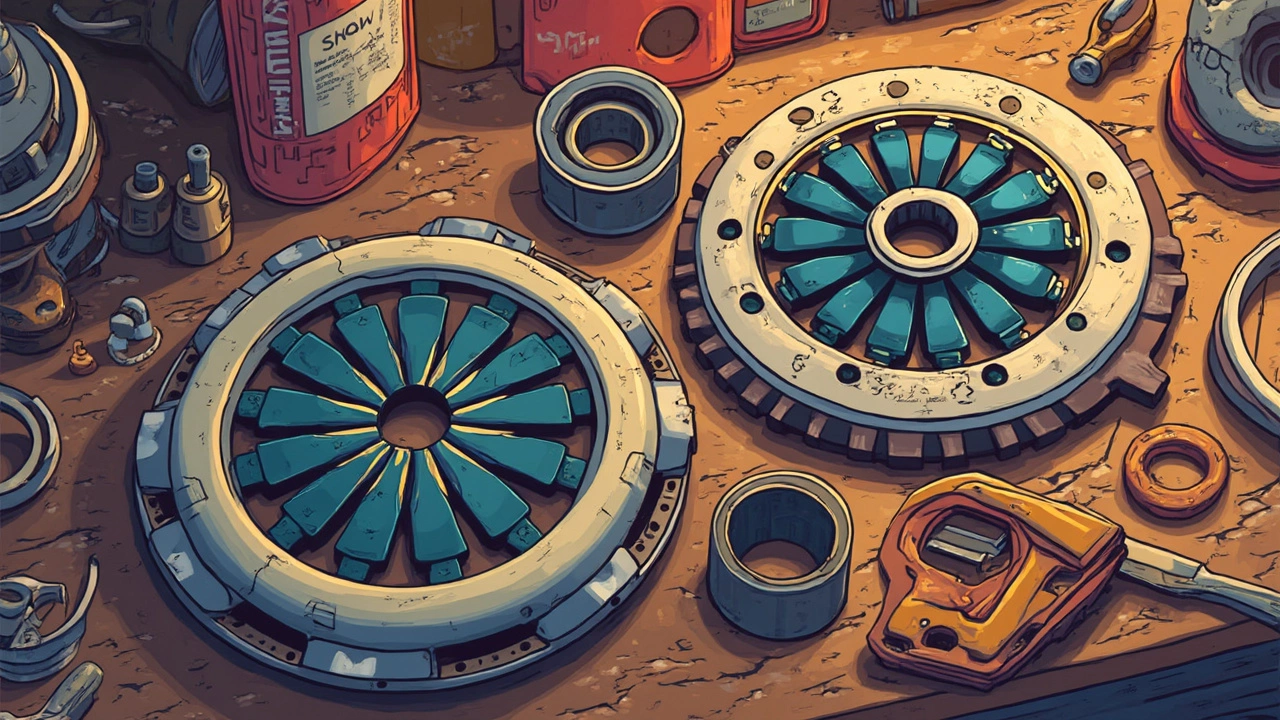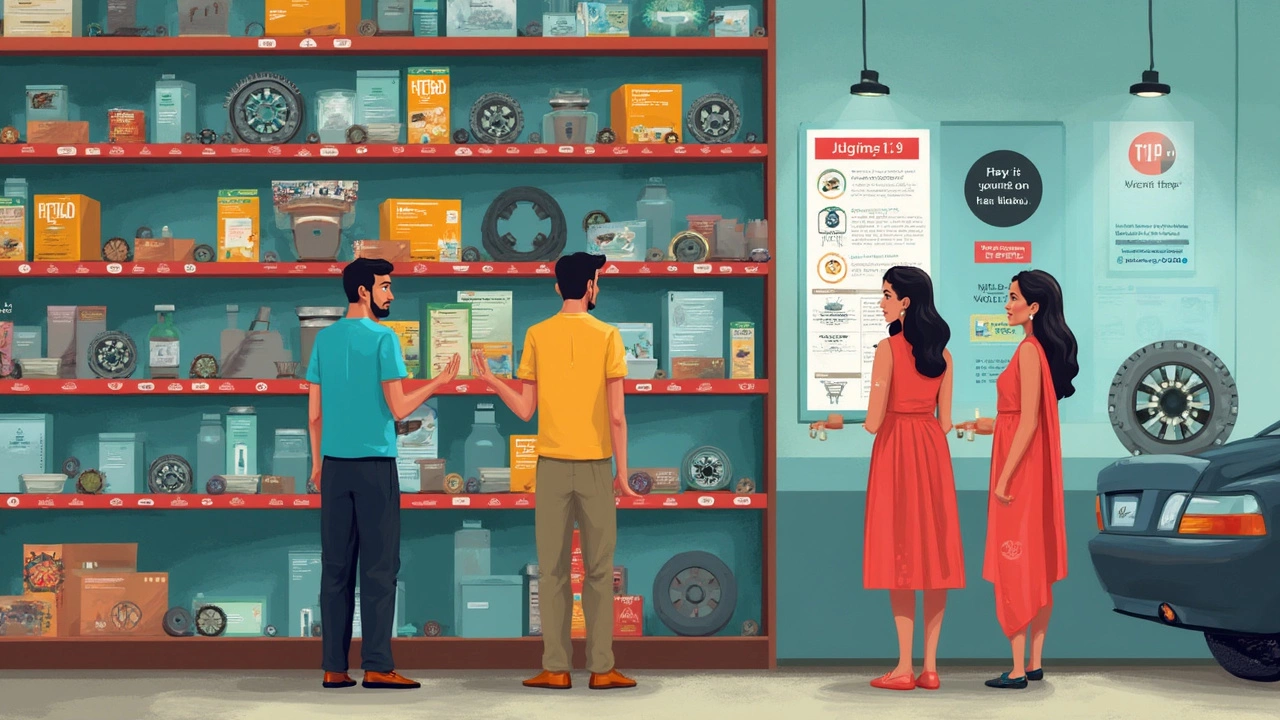 Jul, 2 2025
Jul, 2 2025
You might think your car’s clutch is just one part, hiding between the engine and the transmission. But pop open a clutch kit box and you’ll find a collection of components, each with its own essential job. Forget boring auto manuals with cartoon diagrams—let’s talk about what really goes into a clutch kit, why every piece matters, and what to watch for if yours is acting up. Spoiler: it’s not just about a slipping pedal or that burning smell after driving your cousin’s old stick-shift. There’s way more under the surface.
The Essentials: What’s Actually in a Clutch Kit?
Open any genuine clutch kit and the first thing that hits you—besides the sharp tang of fresh metal—is the complexity. Usually, a clutch kit comes with three main components: the clutch disc, the pressure plate, and the release bearing. Sometimes you’ll also spot a pilot bearing or bushing and an alignment tool tossed in for good measure. Each of these isn’t there for decoration—skip one, and you’ll probably be back on the hoist in a month.
The clutch disc is the workhorse: round, usually with visible friction material around the edge like a thick brake pad. This disc connects the engine’s power to your transmission. The pressure plate looks like a metal frisbee with heavy springs, designed to clamp the clutch disc against the flywheel whenever you let your foot up on the pedal. The release bearing (sometimes called a throw-out bearing) is a compact, tight component that allows you to disengage the clutch smoothly. If you get a pilot bearing, that’s for steadying the end of the transmission input shaft on some vehicles. The alignment tool? Not exactly essential if you’ve got ninja skills, but it’s your ticket to lining up the clutch disc perfectly during the install.
Depending on the make and model, you might also find small parts like bolts, clips, or even a new flywheel, but don’t count on that unless it’s a premium kit. A survey by a major Canadian auto-parts supplier in 2024 showed about 92% of clutch kits included the first three parts, but only 56% came with the alignment tool—so always double-check what you’re getting before you start tearing down your ride.
How Each Clutch Kit Component Does Its Job
Let’s get real—knowing which parts are in the box is only half the story. To really understand what you’re buying, it helps to know what each does once sandwiched between your engine and gearbox. The clutch disc is built to take a beating from friction. Every time you press down the pedal, you’re disconnecting the disc from the spinning flywheel, stopping the engine’s power long enough for you to change gears or come to a stop. After thousands of cycles, the disc’s friction material wears down—once it’s thin, you’ll start to feel that dreaded ‘slip,’ especially when accelerating.
The pressure plate is sprung metal, elegantly simple and ruthlessly strong. Its springs (or sometimes a diaphragm) hold the disc tight against the flywheel, so when the clutch is engaged, power transfers smoothly. Ever noticed a spongy pedal or trouble getting into gear? Damaged pressure plate springs could be at fault. A research paper from McMaster University in 2023 found that more than 60% of clutch issues in vehicles over 120,000 km stemmed from pressure plate fatigue rather than the disc itself.
The release bearing gets ignored till it starts squealing—or worse, seizes up. Its only job: let the pressure plate disconnect smoothly when you press the pedal. When it fails, you’ll spot grinding noises or a stiff clutch pedal. The pilot bearing, meanwhile, is vital in rear-wheel drive cars (like Mustangs or older BMWs), keeping the transmission input shaft spinning straight inside the flywheel. Skipping this tiny part can mean vibration and rapid clutch wear.
Ever used an alignment tool? It’s basically a plastic or metal rod matching your transmission’s input shaft size, helping you center the clutch disc perfectly. Without this little helper, screwing the transmission back into place becomes a near-impossible wrestling match. Pro tip: keeping even a cheap plastic alignment tool in your toolbox saves hours on a clutch swap, especially in winter if you’re working out in the driveway.

Clutch Kit Types: Not One Size Fits All
Walk into any parts store in Hamilton, and you’ll see shelves lined with clutch kits, but they’re far from identical. There are stock replacement kits for daily drivers, performance kits for street racers, and heavy-duty kits for trucks loaded up with payload. Each clutch kit is tailored not just to the car model, but to how you’ll drive it.
Stock kits usually have organic friction material—a balanced blend of smooth engagement and long lifespan. These are what most sedans and hatchbacks use. Performance kits might use ceramic or kevlar pads—these handle heat better and grab harder at high RPM, but can make for a chattery, less forgiving pedal feel. Trucks or commercial vehicles often run sintered iron or metallic discs, which are tough enough for towing but seriously stiff around town.
Prices run the spectrum. In 2025, the average replacement clutch kit for a compact car in Canada runs about $190 to $300. Performance sets regularly go north of $400, especially for imports or high-torque builds. Kits for big trucks can exceed $600, but don’t assume price tells you everything: fitment matters most. A tip from long-time mechanics around here—don’t trust an ‘all-in-one universal kit’ if you need reliability. Always check the reputation of the brand, and look at reviews from drivers with your exact vehicle.
And pay attention to those tiny differences. A Civic clutch kit from 2018 might not fit a 2022 model, even if it looks the same. Mounting holes, spline counts, and pilot bearing sizes change more than you’d expect. One Ottawa garage reported in 2024 that roughly 17% of clutch kits returned were due to improper fit, not actual defects. So double-check those part numbers—and measure twice, not once.
Telltale Signs You Need a Clutch Kit (and When to Upgrade)
If you’re wondering whether it’s time to grab a new clutch kit, just paying attention to your car’s behavior can save you both time and cash. Number one sign: a slipping clutch. If your engine revs go up but the car lurches forward late, the clutch disc is likely worn. Next up, a heavy or sticky pedal—if your left leg gets a workout every commute, you might have a bad pressure plate or a binding release bearing.
Noise means trouble. Squeals or grinding when pressing the clutch pedal often mean the release bearing is dying. Of course, sometimes it’s just a dry bearing, but ignoring it risks damage to the pressure plate or even the transmission. Poor engagement or trouble getting into gear? Misalignment or worn bearings can make shifting tough, or cause the car to creep even with the pedal down.
One trick: press the clutch pedal and listen for a change in sound. If rattling disappears when you press it, the issue might be your release bearing. If it rattles only when the pedal is up, the culprit could be a worn clutch disc. Mechanics in Hamilton suggest watching for leaks in the bell housing area—leaking fluid can destroy friction material fast. If you smell burnt toast after aggressive driving or towing, it’s probably time for a new kit.
If you push your car harder than average—say, track days or towing a trailer—consider upgrading to a performance or heavy-duty kit. These are designed for higher temps, more abuse, and quicker shifts. Just make sure your daily drive is still manageable: performance clutches can make city stop-and-go a chore.

Tips for Buying and Installing Your Clutch Kit
No one likes forking out cash for repairs, but clutch work is one spot where shortcutting can cost way more down the line. Here’s a checklist to avoid hassle. First—research your car’s make, year, and engine code. Always buy from a reputable supplier, and insist on a full parts list before paying. Some brands bundle new flywheel bolts or even the flywheel itself, but plenty just include the basics.
Consider replacing the flywheel or at least having it resurfaced if the old one shows hot spots or grooves—installing a new clutch on a rough flywheel is like putting new shoes on a broken foot. Grab a new alignment tool (they cost mere dollars), and check your kit includes all the right-size bearings and bushings.
When installing, always torque bolts to spec, and work in a star pattern for even pressure. Bleed the hydraulic system if your car uses one. Don’t touch the friction surfaces with oily hands—grease ruins clutches fast. Test fit every part before bolting things up, and rotate the disc by hand to check for binding. If you’re not confident, don’t improvise: a botched clutch install can leave you stuck, or worse, damage the transmission or engine seals.
If you want to shop smart—or just geek out on data—check this quick table I pulled from Canada’s national parts suppliers, showing average 2025 clutch kit prices by car segment:
| Vehicle Type | Typical Kit Price (CAD) | Main Friction Material |
|---|---|---|
| Compact Car | $190–$300 | Organic |
| Mid-size Sedan | $250–$400 | Organic |
| Performance/Sports | $380–$650 | Ceramic/Kevlar |
| Pickup/Utility | $400–$700 | Sintered Iron |
One last note: store your clutch kit in a dry place, away from oil, dust, and dirt until you’re ready to install. Moisture or grime can kill the friction material before it even goes into the car. And always keep the box and receipt—warranties matter. With the right clutch kit and install, you’ll get another hundred thousand kilometers of smooth shifts, and maybe even teach your friends how to really drive a manual the way it’s supposed to be done. Just go easy on that first launch out of the driveway.